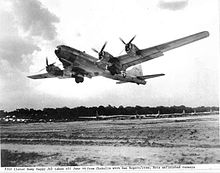Chakulia Airport
This article includes a list of general references, but it lacks sufficient corresponding inline citations. (September 2010) |
Chakulia Airfield | |||||||||||
|---|---|---|---|---|---|---|---|---|---|---|---|
| |||||||||||
| Coordinates | 22°28′00.49″N 086°42′38.52″E / 22.4668028°N 86.7107000°E | ||||||||||
| Website | Chakulia Airport | ||||||||||
| Map | |||||||||||
| Runways | |||||||||||
| |||||||||||

Chakulia Airport is an airport in
Currently, the airport has no scheduled
History
Chakulia Airfield was built by the
In addition, the
In December 1944, the 341st Bomb Group moved to China and the airfield was designated as a

Chakulia was designated to be the home of the
It had taken nearly two weeks for the group to arrive at Chakulia from Kansas, deploying over the South Atlantic transport route. The deployment consisted of traveling to Morrison Field,
, before arriving at Karachi. By the time the group arrived at Chakulia, the month-long trip had taken its toll on the aircraft and personnel. Also, when the group arrived, the conditions at the base were poor, and the runways were still in the process of being lengthened when the first B-29s arrived.In addition to the 40th, its command unit, the
Almost immediately upon arrival, the groups B-29s were grounded due to engine fires, which were caused by the engines not being designed to operate at ground temperatures higher than 115 degrees F, which were typically exceeded in India. Modifications had to be made to the engines and also to the cowl flaps. After these modifications, B-29 flights were resumed.
From India, the 40th Bomb Group planned to fly missions against
However, all the supplies of fuel, bombs, and spares needed to support operations from Kwanghan had to be flown 1,200 miles from India over "
The first combat mission by the group took place on June 5, 1944, when squadrons of the 40th took off from India to attack the Makasan railroad yards at Bangkok, Thailand. This involved a 2261-mile round trip, the longest bombing mission yet attempted during the war.
On June 15 the group participated in the first American Air Force attack on the
, in August 1944.The 40th evacuated staging fields in China in January 1945 due to the Japanese offensive in South China which threatened the forward staging bases, but continued operations from India, bombing targets in Thailand and mining waters around Singapore. However, by late 1944 it was becoming apparent that B-29 operations against Japan staged out of the bases in Chengtu were far too expensive in men and materials and would have to be stopped. In December 1944, the Joint Chiefs of Staff made the decision that Operation Matterhorn would be phased out, and the B-29s would be moved to newly captured bases in the Marianas in the central Pacific.
On 25 February 1945, the 40th Bombardment Group flew south to
With the departure of the B-29s in March 1945 to the Marianas, Chakulia Airfield was returned to Tenth Air Force. It was kept, however, largely in reserve status, with the 28th Service Group performing caretaker activities, with the occasional aircraft transiting the airfield.
With the last Americans leaving in late 1945, the airfield was turned over to the British colonial government. The postwar history of the airfield is unclear, however it is used today as a civil airport. The large, sprawling wartime airfield is largely in disrepair, with abandoned hardstands and taxiways visible on aerial images.
See also
Notes
- The Telegraph (Calcutta). 18 July 2006. Archived from the originalon April 8, 2014. Retrieved 5 February 2012.
References
![]() This article incorporates public domain material from the Air Force Historical Research Agency
This article incorporates public domain material from the Air Force Historical Research Agency
- Maurer, Maurer (1983). Air Force Combat Units Of World War II. Maxwell AFB, Alabama: Office of Air Force History. ISBN 0-89201-092-4.
- Ravenstein, Charles A. (1984). Air Force Combat Wings Lineage and Honors Histories 1947–1977. Maxwell AFB, Alabama: Office of Air Force History. ISBN 0-912799-12-9.




